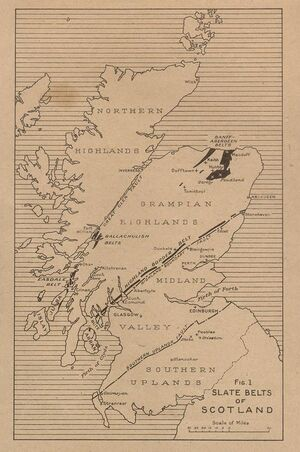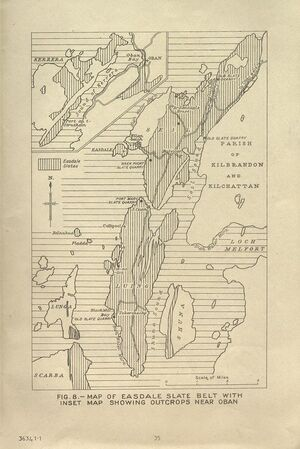Slate belts of Scotland
| From: Richey, J.E. and Anderson, J.G.C. 1944. Scottish slates. Wartime pamphlet No. 40. London : Geological Survey of Great Britain. |
Introduction



Probably few Scottish industries have been carried on for such long periods at particular places as slate-quarrying. Its stability is to be ascribed to two main reasons: (1) the essential nature of the industry in a country where a durable roofing material is usually required; and (2) the almost inexhaustible amounts of slate-rock available at or near the localities originally selected for large-scale exploitation. Yet the winning of slate has had numerous handicaps to content with, some imposed by external economic factors and others by the nature and distribution of the Scottish slates themselves. As in the case of many other Scottish industries based upon mineral resources, the geological and topographical conditions are often more difficult than further south.
The Scottish slate belts enter into the core of an ancient mountain-range which, at one time, extended north-eastwards across the Highlands to Scandinavia. Owing to their situation geological difficulties more often arise in the case of the Scottish slate belts than in those of Wales, which lie near the outer edge of the Caledonian mountain-system, as the range is termed. The rocks, too, probably differ in geological age. With unimportant exceptions, the slates of the Highlands form part of a great assemblage of altered rocks, mainly of sedimentary origin, termed the Dalradian Series. The geological age of the series is not accurately known, although the balance of opinion is in favour of assigning it to a pre-Cambrian date. The slates of Wales, on the other hand, are definitely of Cambrian and later age (Lower Palaeozoic).
Hard shales once worked extensively for roofing purposes occur in the post-Cambrian (Ordovician and Silurian) rocks of the Southern Uplands of Scotland, at Stobo Quarry in Peeblesshire and various other localities (P519813) . They, however, are not true slates. They do not possess slaty cleavage, but owe their fissility simply to original bedding. They are thick and heavy, and only in the days when local requirements had to be met, if possible, from local sources were they of economic value. Thinly splitting flagstones of Old Red Sandstone age occurring in Angus, Caithness and Orkney were also used at one time for roofing purposes, but, like the shales of the Southern Uplands, they owe their fissility to bedding, and are not true slates. No details of these pseudo-slates are included in the present account.
The belts of true slate in the Highlands all fall within the subdivision of that regional known as the Grampian Highlands. Geologically, as well as topographically, the south-east margin of the Grampian Highlands is determined by a major fracture, termed the Highland Boundary Fault, which has been traced from Stonehaven across Scotland to North Arran, and the north-west margin by another major break in the Earth’s crust, the Great Glen Fault, which is followed by the line of the Caledonian Canal.
The main slate belts of the Grampian Highlands are as follows (P519813) :-
- Ballachulish belts (P519817) , extending from the quarries around Ballachulish, on the south side of Loch Leven, south-westwards for 6 miles as well as north-east of the loch, and from the North Ballachulish quarry, 1½ miles East of Onich, north-eastwards for 7½ miles almost to Glen Nevis. The group of slate rocks concerned is termed by geologists the Ballachulish Slates.
- Easdale belt (P519820) , extending north of Jura through the islands of Scarba, Belnahua, Luing, Shuna and Easdale to Seil, and thence northwards to Oban a distance of 20 miles. This group is termed the Easdale Slates.
- Highland Border belt (fig. 11), extending on the north-western (Highlands) side of the great Highland Boundary Fault from the north of the Island of Arran, north-eastwards through the Island of Bute, across Loch Lomond at Luss, and past Aberfoyle, Comrie and Logiealmond (Craiglea Quarry) to Dunkeld, with an extension farther east-north-east that reaches the east coast to the north of Stonehaven. This group is termed the Aberfoyle Slates.
- Banff-Aberdeen belts (P519813) , including:- (a) the group termed the Macduff Slates, which stretch southwards from the coast at Macduff to a line of quarries in Northern Aberdeenshire south of Huntly; and (b) less important outcrops on different geological horizons near Keith, Dufftown and Tomintoul.
The Highland slates have been entirely worked by opencast methods, both the seams of slate-rock and the cleavage being in general inclined at high angles. Wherever high working faces are obtained, as is often the case, the face is taken back in a series of benches and galleries. The best slate-rock [1] is usually restricted in a quarry to one or more particular bands or seams. In some cases a number of seams have been exploited, and the intervening poorer quality material taken out at the same time. In others a single thick seam may occur. Even in the most favourable cases, a great deal of waste slate has to be dealt with, and it is seldom that more than 8 per cent of the entire output from a quarry is in the form of marketable slate. In consequence, one of the chief problems with which the quarry-master is faced is the removal and disposal of waste slate. Nevertheless, quarries have in most cases been worked to a finish before a new opening has been made further along the particular slate belt concerned. In some places (e.g. Balvicar, Seil) quarries opened up on flat ground have been driven to depths of 200 ft or more below ground-level. In others (e.g. Ballachulish Main Quarry) excavations have been made in a steeply rising hill-side as well as to depth.
- ↑ In order to avoid any misunderstanding which might arise in regard to the resources of marketable slate, the rock termed slate in the geological sense is often referred to in this account either as slate-rock or by the geological name applied to the slate group concerned, such as the Aberfoyle Slates.